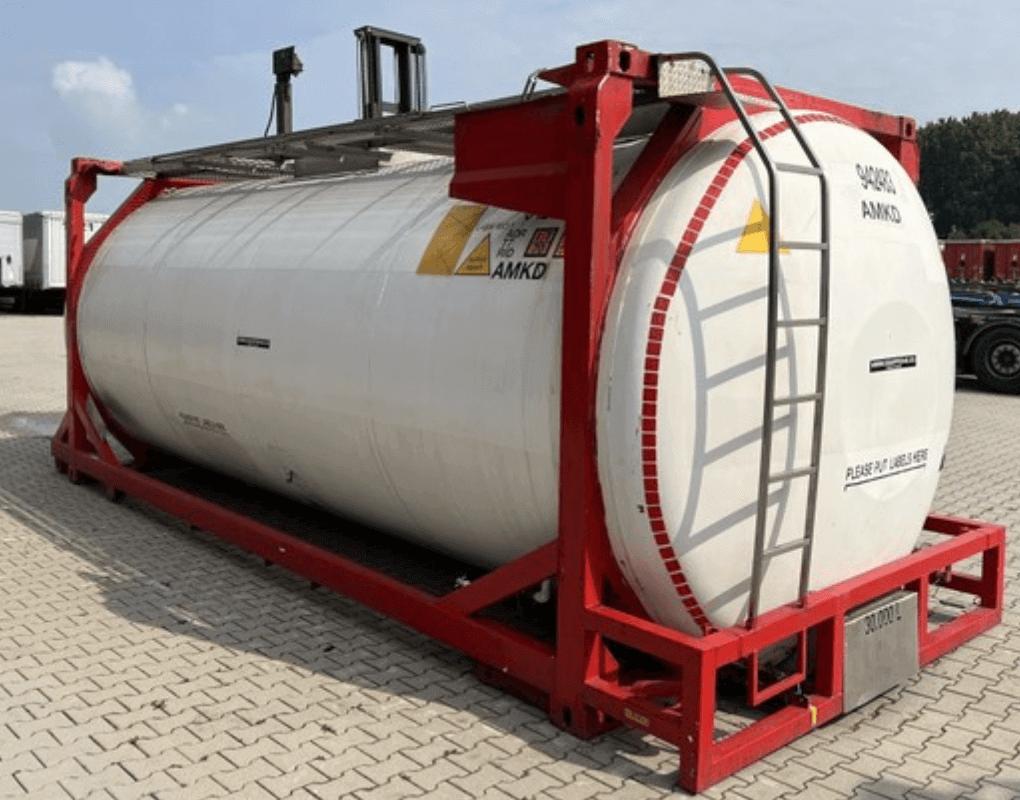TANK CONTAINER
A tank container, also known as an ISO tank or tank, is a specially designed container intended for the transport of liquid or gaseous substances. They are made of a steel casing that is able to withstand pressure and impacts. They are compatible with international ISO standards for shipping containers. The capacity of a tank container is standard from 14,000 liters to about 26,000 liters, and they are available in different sizes and variants. It is always necessary to choose a specific tank according to the intended content. These tank containers are suitable for smaller volumes of transported substances. They are easier to handle, as they have a lower weight even compared to transport on trucks or by rail.
20′ tank containers are commonly used for liquid substances, but there are also 40′ tank containers on the market, which have a capacity of roughly 50,000 to 66,000 liters – depending on the manufacturer. These containers are suitable for larger volumes of liquid substances and are often used to transport petroleum products, chemicals or food products that require a larger volume. However, they are not commonly sold in the Czech Republic. Such large tank containers are mainly used in countries such as China, Japan, America, the Netherlands and Germany. This is because the requirements for transporting chemicals are higher here.

What is a container tank used for?
These tank containers are widely used for the transportation of various liquids and gases such as petroleum products, chemicals, food substances and pure gases such as oxygen or ammonia.
Tank containers are also used to transport and store bulk loose substrates, especially cement, lime, kaolin, etc. They are also used to transport various types of liquids (oil, diesel, acids, beverages, etc.) and compressed gases.
However, if we want to change the type of transported substrate, it is necessary to clean the tank container carefully, which is not an entirely simple matter with some types of substrate.
During transport, the container is often placed on special chassis or wagons and is adapted for handling as part of intermodal transport. This means it can be transported by road, ship or rail.
Tanks are an important element in international logistics and the transport of liquids and gases. They enable the efficient, safe and economical transport of various liquids around the world.
How is a tank container manufactured?
They are made of a steel shell that is strong, durable and capable of withstanding pressure and impact. The main part of the tank container is usually a cylindrical pressure vessel, i.e. a stainless steel tank. It’s horizontally placed in the supporting structure of the container. That is, in its outer frame.
The filling of the container is done through the filling nozzle and the emptying is pneumatic using positive pressure or gravity. Hoses are used for filling liquids.
Container tank is equipped with valves, ventilation systems and other safety features. That ensure the correct handling and transport of dangerous or sensitive substances. Inside the tank container is a unit called a “tank” which is sealed and secured against any leakage of the substance, which also applies to the protection of the “cargo” inside.
These containers are very complex in terms of construction and equipment. They are the most expensive to operate. Also the cost of transportation or rental is often high for these reasons.
Tank containers production
For the production of tank containers, high-strength steel No. 316 is most often used, which is able to withstand pressure, impacts and corrosive influences.
Steel shell of the container is shaped using a special pressing process. The casing is usually made of two or more sections which are then welded together. Internal tank, which is used to store liquid or gaseous substances, is installed in a steel casing. Tank container is made of a compatible material that is resistant to the transported substances.
Container is equipped with various valves, fittings and safety elements that ensure proper handling and safety of transported liquids and gases.
After completion of production, tank containers are subjected to various tests. Such as leak test, pressure resistance test and other safety tests that they have to meet before they start their journey with cargo. They must then undergo certification that confirms their compliance with international standards and regulations.
Shipping containers offer great variability in dimensions and design. You can see their detailed overview in the section on shipping containers.
You can buy a TANK CONTAINER in these sizes:
 | TANK CONTAINER – cistern | |||||||
| External dimensions (m) | Weight kg | Capacity | ||||||
| CONTAINER TYPE | length | wide | height | container | maximum load capacity | l | ||
| 20′ | 6,058 | 2,438 | 2,591 | 3070 až 4190 | 26290 | 21000 | ||
| 40′ | 12,192 | 2,438 | 2,591 | 6800 až 8000 | 36000 | 45000 | ||
Before using a tank container, it is always necessary to verify the exact capacity with the manufacturer or supplier and to comply with the relevant transport regulations.
It is always important to take into account the current laws and regulations regarding transport and the permissible weight limits in different countries.
After exploring the ins and outs of tank containers, you might be interested in learning about the different kinds of shipping containers. Discover their uses and why they are so crucial in global trade. If you're curious about more specific types, check out the bulk containers that are perfect for transporting loose materials. They offer unique solutions for specific cargo needs. For those considering extra storage space, the container garage might catch your attention. It provides insights into selecting the right size and setup for your container-based garage. Finally, if you have any questions or need further assistance, don’t hesitate to reach out through our contact page. Our team is ready to help with all your container needs.

